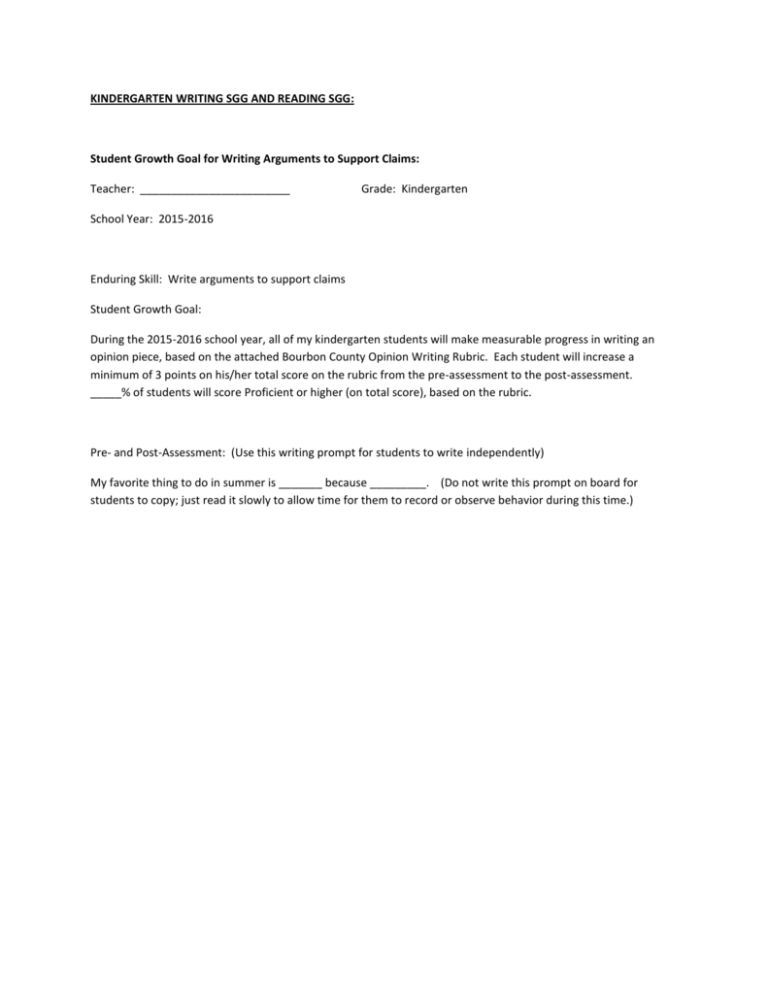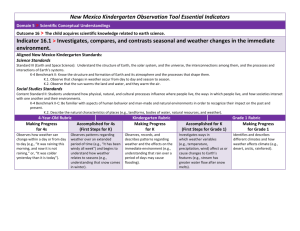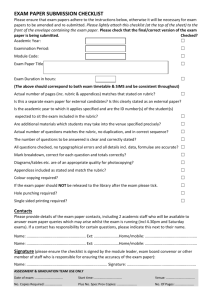Student Growth Goal/Rubric/Assessment
advertisement

KINDERGARTEN WRITING SGG AND READING SGG: Student Growth Goal for Writing Arguments to Support Claims: Teacher: ________________________ Grade: Kindergarten School Year: 2015-2016 Enduring Skill: Write arguments to support claims Student Growth Goal: During the 2015-2016 school year, all of my kindergarten students will make measurable progress in writing an opinion piece, based on the attached Bourbon County Opinion Writing Rubric. Each student will increase a minimum of 3 points on his/her total score on the rubric from the pre-assessment to the post-assessment. _____% of students will score Proficient or higher (on total score), based on the rubric. Pre- and Post-Assessment: (Use this writing prompt for students to write independently) My favorite thing to do in summer is _______ because _________. (Do not write this prompt on board for students to copy; just read it slowly to allow time for them to record or observe behavior during this time.) Score with this rubric: Student Growth Goal for Writing Enduring Skill: Writing arguments to support claims (W1) Grade Level: Kindergarten Subskill: Below Proficient Above Idea Development (W1) Uses only drawing and dictating to compose opinion piece in which they tell a reader the topic or name of a book and state an opinion or preference about the topic or book OR does not give an opinion at all Uses a combination of drawing, dictating, and writing to compose opinion piece in which they tell a reader the topic or the name of the book they are writing about and state an opinion or preference about the topic or book (My favorite book is…) Writes opinion piece on topic or text. Introduces the topic or text, states an opinion and provides one or more reasons to support the opinion; concluding statement is also provided Organization - Writing Expectation Per Grade Level Uses a fragmented sentence to give an opinion or a nonsense response Uses a complete sentence to give an opinion Creates an organizational structure using an opening sentence, a middle sentence stating the opinion/reason, and a closing sentence Spacing between words Uses random letters with no spacing to show word units Consistently uses spaces between words Hearing and Recording Sounds in Words (L2d) Conventions -Capitalization (L2a) Unable to hear and record sounds in words, even for initial sounds; reader is unable to read what is written Lacks use of capitalization when writing Conventions -Punctuation (L2) Lacks use of punctuation when writing Uses spaces between word units, even though not consistently Uses phonetic spelling for words, hearing and recording the prominent sounds in most words in correct sequence Begins sentence with a capital letter and uses capital I for the word “I” Demonstrates appropriate use of ending punctuation when writing, including period and question mark Uses conventional spelling words for some sight words and some phonetically correct words ---- ------ Scoring Based on the Rubric: There are 6 subskills with 2 or 3 categories, so the maximum number of points that could be earned from a student would be 16 points. If a student scores 6 to 9 points total, that is a “Below Level” score. If a student scores 10 to 14 points total, that is a Proficient score. If a student scores 15 to 16 points total, that is a “Above Level” score. There would not be percentage scores, just total number of points to determine which category. Below the rubric, an area for “Next Teaching Points” for teachers to reflect on which areas are weak for each student. Student Growth Goal for Foundational Reading Skills: Teacher: ________________________ Grade: Kindergarten School Year: 2015-2016 Enduring Skill: Apply phonics and word analysis in decoding text Student Growth Goal: During the 2015-2016 school year, all of my kindergarten students will make measurable progress in applying phonics and word analysis skills to decode text, based on the attached Bourbon County Foundational Reading Skills/Phonics Rubric. Each student will increase a minimum of three points on total points earned (16 possible points) from the pre-assessment to the post-assessment. _____% of students will have an overall score of Proficient or higher (10 to 16 points), based on the attached rubric. Pre- and Post-Assessment (Use this same assessment): 1) Ask student all uppercase and lowercase letters (total of 52) 2) Ask student all consonant sounds (show the letter and ask for the sound) 3) Have students read words under each heading (for the words, if child reads 3 or less, score is below level; if child reads 4 or 5 words, score is proficient; if child reads 1 or 2 of the extra words, score is above level. **Note: Only ask for the Above Level words if student reads at least 4 of the 5 words. CVC Words: pet mop bug rip sat Above level: flip, last Consonant Digraph Words: the ship chop with she Above level: chick, wish Long Vowel Words: like cake rope keep cute Above level: tube, week Sight Words: you little see like to Above level: here, this Score with this rubric: Student Growth Goal: Foundational Reading Skills/Phonics and Word Recognition (RF 1 & 3) Enduring Skill: Apply phonics and word analysis in decoding text Grade Level: Kindergarten Subskill: Below Proficient Above Letter Identification (RF1) Recognizes and names 48 or less of upper and lowercase letters of the alphabet -------- Letter-Sound Correspondence for Consonants (RF3a) Demonstrates basic knowledge of one-to-one letter-sound correspondence by producing the primary sound for 15 or fewer consonants Associates the long or short sounds with the common spellings for the five major vowels OR can do short and long, but inconsistently Unable to read common highfrequency words by sight Recognizes and names at least 49 of the 52 upper and lowercase letters of the alphabet (standard says all) Demonstrates basic knowledge of one-to-one letter-sound correspondence by producing the primary sound for at least 16 of the 21 consonants Associates the long and short sounds with common spellings (graphemes) for the five major vowels Reads common highfrequency words by sight (e.g., the, of, to, you, she, my, is, are, do, does) Reads phonetically correct CVC words and can distinguish between similarly spelled words by identifying the sounds of the letters that differ Knows the spelling-sound correspondences for the three common consonant digraphs (sh, th, ch) Reads above-grade-level high- frequency words by sight Vowel Sounds – Long and Short (RF3b) Sight Words (RF3c) Reading CVC words (RF3d) Unable to read CVC words and distinguish between two similarly spelled words Consonant Digraphs (sh, th, ch) Unable to identify the three common consonant digraphs --------- Knows and uses vowel teams to represent vowel sounds in decoding words Reads higher level words with common spelling patterns and consonant blends (ex. truck) Decodes words with consonant digraphs Scoring Based on the Rubric: There are 6 subskills with 2 or 3 categories, so the maximum number of points that could be earned from a student would be 16 points (Above Level in all 6 subskills). If a student scores 6 to 9 points total, that is a “Below Level” score. If a student scores 10 to 14 points total, that is a Proficient score. If a student scores 15 to 16 points total, that is a “Above Level” score. There would not be percentage scores, just total number of points to determine which category. Below the rubric, an area for “Next Teaching Points” for teachers to reflect on which areas are weak for each student.








